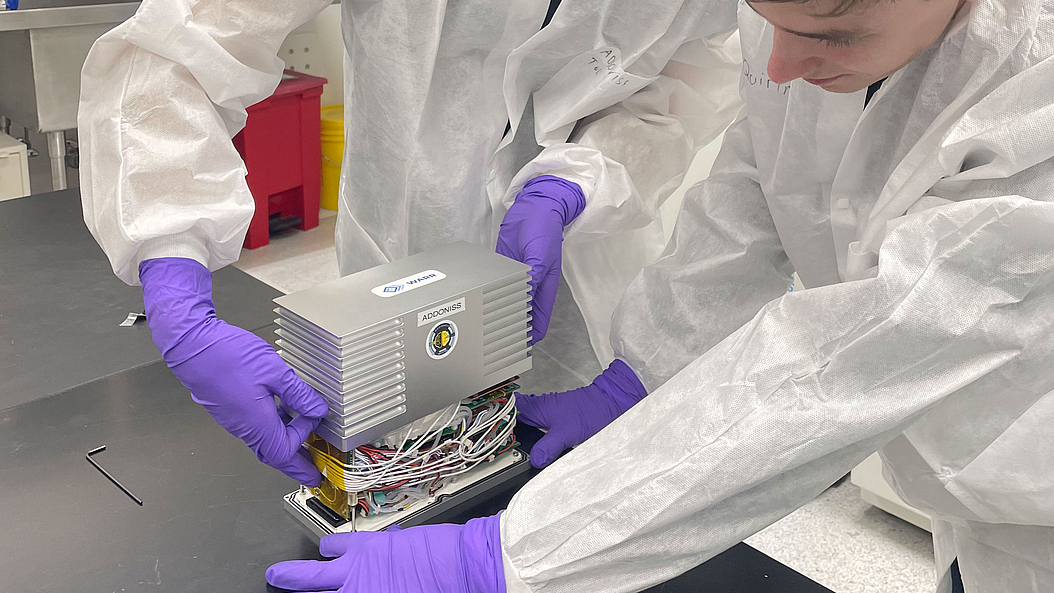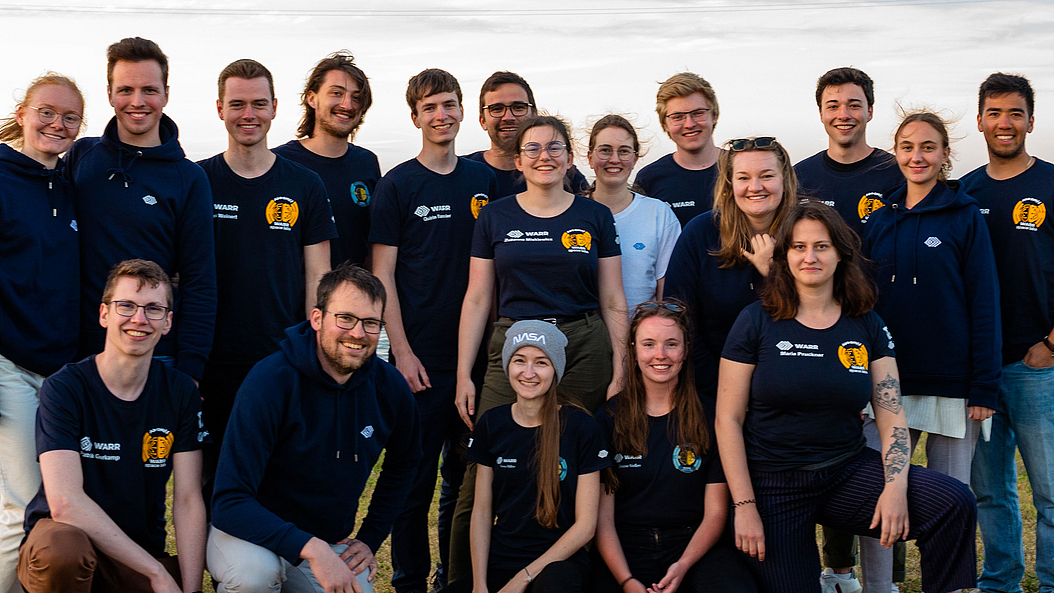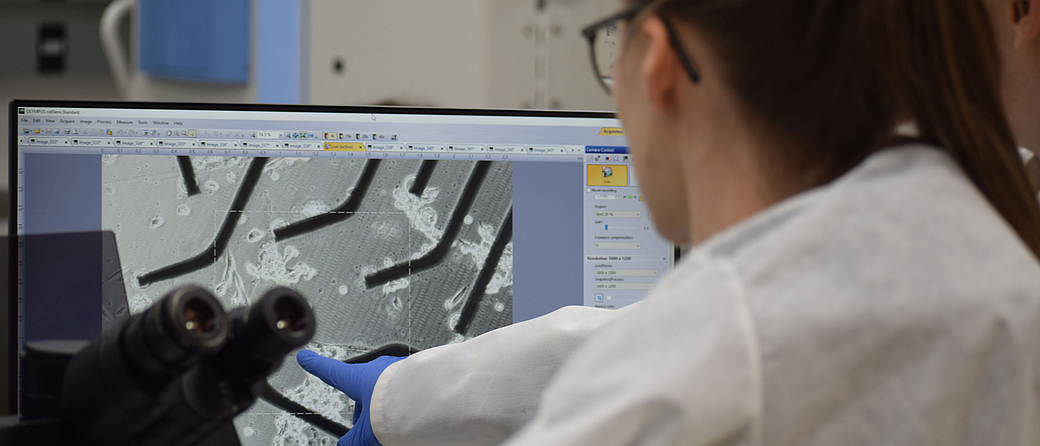In March 18 TUM students followed the launch of a Falcon 9 launch vehicle from Kennedy Space Center in person. A box in the cargo compartment contained an experiment the young researchers had developed to investigate the aging process of brain cells, to be conducted aboard the International Space Station ISS.
"Being in the Kennedy Space Center in Florida and watching a rocket take off is really something special. But being present at lift-off and knowing that there's an object which you built yourself on board the rocket, that's just incredible," says Fanny Rößler, WARR space labs teamlead.
The excitement before launch, the countdown, the deafening roar of the engines, the sight of the rocket shooting into the sky, growing smaller with each passing second: "Those are moments none of us will ever forget," says Fanny Rößler with confidence.
Victory in "Überflieger 2" competition
Fanny Rößler, who had just begun her Master's program in Bioinformatics, has been on board with the project from day one: "I've always been completely fascinated by everything that has to do with space flight. And when I heard that the project was supposed to deal with neuroscientific issues, I was immediately thrilled – I really want to know how the brain works."
For months she worked together with electrical and mechanical engineers, physicists, information scientists and life sciences students to formulate the concept for an experiment in space. The objective: Participating in the "Überflieger 2" (Flyover 2) competition for students, put on by the German Space Agency at DLR and the Luxembourg Space Agency. The winning teams were to have an opportunity to conduct their own experiments aboard the International Space Station ISS.

Neurons in zero gravity
"The ISS is a highly interesting test environment for the investigation of biological processes, because the gravitational force of the earth is barely perceivable there. We know that zero gravity has an impact on molecular processes and thus also on the aging process cells undergo. Our idea was to investigate whether or not brain cells age faster in zero gravity and how the beta amyloid protein, which plays an important role in Alzheimer's disease, affects this process," Rößler explains.
The team entered its concept for the research project ADDONISS – short for "Ageing and Degenerative Diseases of Neurons on the ISS" – in the "Überflieger 2" competition. They won one of the coveted spots on the ISS.
"That was actually just the beginning of all the work, since now we had to implement our idea in practice; on top of that, we had to do it in such a way that the experiment would fit in a small metal box measuring 20 by 10 by 10 cm, could withstand a rocket take-off and could run on board the ISS without human intervention. That was an enormous challenge," Rößler recalls.
NASA and ESA regulations
In order to research the brain cells, the team had to develop multi-electrode arrays which could be used to measure the tiny voltages between the neuronal cells. To do this, the team worked with researchers from the Munich Institute of Biomedical Engineering (MIBE) at TUM, who adapted and produced the microelectrode arrays specifically for this purpose. They also needed miniaturized components: sensor technologies, pumps for the nutrient solution and a heating system which would provide a stable temperature of 37 degrees Celsius.
In addition, all the development steps had to comply with the rules of NASA and ESA, which precisely define the materials that can be used on a space mission and the tests which have to be conducted before the launch, Rößler reports: "And that's a lot more work than you might think."
Specially manufactured microelectrodes at MIBE
Inola Kopic, doctoral candidate in the Neuroelectronics Research Group at the Munich Institute of Biomedical Engineering (MIBE) says: "We adapted the layout of the microelectrode arrays specifically for this project to the constraints of the box and the data collection system, and manufactured the chips for it in the MIBE labs. In addition to the electrical measurement of the cellular signals, the activity of the cells is also examined using a microscope. For this, we used a particularly thin, stable, and transparent material for the arrays. In addition, the materials that are in direct contact with the cells had to be biocompatible, i.e. well-tolerated by the cells."
Biological experiments often have to be chemically fixed or frozen in aerospace in order to be able to analyze them later on the earth. However, with the microelectrode arrays and the specially developed read-out system, the cells can be continuously monitored throughout the experiment. This makes measurements possible directly on-site without human intervention.
Test, test and test again
For more than a year two sub-teams of the group – one in Garching specialized in technology and one in Straubing focusing on biology – worked hard on the details. "One major challenge was locating failure-prone points. We were constantly testing. Nevertheless, we discovered a short-circuit right before the launch and had to replace the components – we were all working the night shift," the team leader recalls.

Experience for life
Rößler adds that this last phase in development was the most difficult for her personally: "My task was to prioritize, to decide which components were system-relevant and had to be tested once again before launch. These decisions involved an awful lot of responsibility. You don't learn to deal with that kind of pressure during university studies. But it's great preparation for professional life."
Now that the ADDONISS experiment has already taken off with the Falcon 9 rocket, the space labs team no longer has a chance to do any fine-tuning. The experiment will run automatically for one month.
Until the box returns to Munich, Rößler and her team can only cast a hopeful gaze to the sky when the ISS passes over Munich: "Our experiment flies by up there every 90 minutes."
More Information
- Original TUM News (Monika Weiner / Verena Meinecke)
- The Falcon 9 launch vehicle lifted off from Kennedy Space Center on March 15, 2023.
- The space labs team of the student initiative WARR (Scientific Workgroup for Rocketry and Spaceflight) spent more than one year preparing for the day.
- Brain research in space (interview with WARR member Selina Kanamüller from TUM Campus Straubing)
- Student group WARR an der TUM
Contact Media Relations
Technical University of Munich
Corporate Communications Center
Verena Meineke
presse@tum.de
Media Relations MIBE
presse@bioengineering.tum.de
Scientific Contact
WARR e.V.
c/o TUM Chair of Astronautics
Boltzmannstrasse 15
85748 Garching
Germany
phone +49 (0) 89 289 16028
info@warr.de
